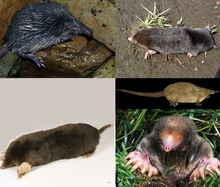| Talpidae Temporal range:
| |
|---|---|

| |
Left column:
| |
| Scientific classification | |
| Domain: | Eukaryota |
| Kingdom: | Animalia |
| Phylum: | Chordata |
| Class: | Mammalia |
| Order: | Eulipotyphla |
| Superfamily: | Talpoidea |
| Family: | Talpidae G. Fischer, 1814 |
| Type genus | |
| Talpa Linnaeus, 1758
| |
| Subfamilies | |
The family Talpidae[1] (/ˈtælpɪdiː/) includes the true moles (as well as the shrew moles and desmans) who are small insectivorous mammals of the order Eulipotyphla. Talpids are all digging animals to various degrees: moles are completely subterranean animals; shrew moles and shrew-like moles somewhat less so; and desmans, while basically aquatic, excavate dry sleeping chambers; whilst the quite unique star-nosed mole is equally adept in the water and underground. Talpids are found across the Northern Hemisphere of Eurasia and North America (although none are found in Ireland nor in the Americas south of northern Mexico), and range as far south as the montane regions of tropical Southeast Asia.
The first talpids evolved from shrew-like animals which adapted to digging late in the Eocene in Europe. Eotalpa anglica is the oldest known mole, it was discovered in the Late Eocene deposits of Hampshire Basin, UK.[2] The most primitive living talpids are believed to be the shrew-like moles, with other species having adapted further into the subterranean, and, in some cases, aquatic lifestyles.[3]
- ^ Hutterer, R. (2005). Wilson, D.E.; Reeder, D.M. (eds.). Mammal Species of the World: A Taxonomic and Geographic Reference (3rd ed.). Johns Hopkins University Press. pp. 300–311. ISBN 978-0-8018-8221-0. OCLC 62265494.
- ^ Jerry J. Hooker. Skeletal adaptations and phylogeny of the oldest mole Eotalpa (Talpidae, Lipotyphla, Mammalia) from the UK Eocene: the beginning of fossoriality in moles. The Paleontological Association. Volume59, Issue 2, March 2016. pp. 195-216. doi.org/10.1111/pala.12221
- ^ Savage, RJG, & Long, MR (1986). Mammal Evolution: an illustrated guide. New York: Facts on File. p. 53. ISBN 0-8160-1194-X.
{{cite book}}: CS1 maint: multiple names: authors list (link)